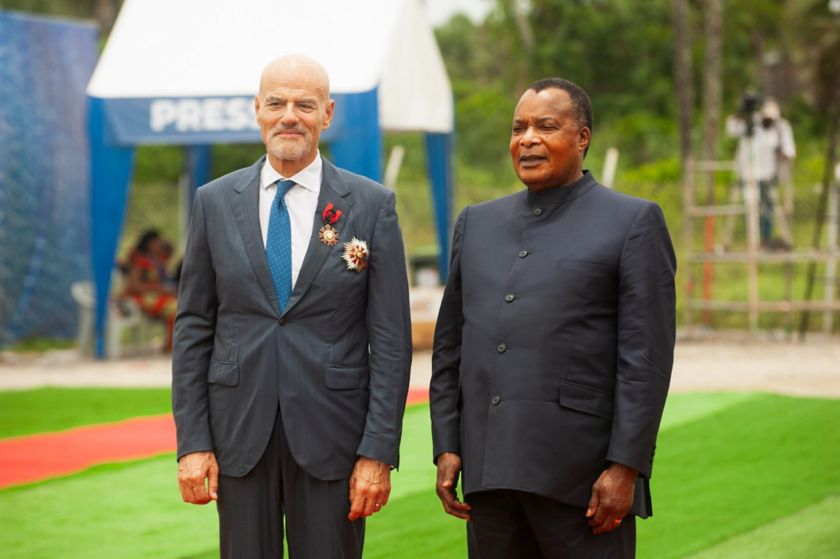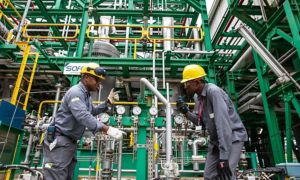Type of activity
Liquid natural gas (LNG)
Oil & Gas

Or , our new artificial intelligence tool.

Congo LNG is the first natural gas liquefaction (LNG) project in the Republic of Congo. The installation of new infrastructure and the optimisation of existing facilities allow the abundant gas resources, associated and not, to be tapped, thus supplying both the local electricity market and exports to other countries, with Europe as the main destination.
Country: The Republic of Congo
Activity start date: 2022 – present
The Congo LNG project, currently in its production phase, was implemented with simultaneous exploration and development activities to accelerate production. Using a zero-flaring technological approach to reduce fugitive methane emissions, the project enables the Republic of the Congo to export liquefied natural gas (LNG) and thus support its economic growth, in line with Eni’s decarbonization strategy.
This initiative, which has increased the overall production capacity of the Marine XII concession to be increased up to 3 MTPA, includes the construction of onshore facilities and of infrastructure necessary for natural gas processing. It also involves the installation of two floating natural gas liquefaction (FLNG) plants on the Nenè and Litchendjili fields, which are already in production, and on discoveries not yet developed. The development of the project includes the construction of the onshore plants and infrastructure which will allow, upon completion of the works, the treatment of natural gas. The first LNG cargo was allocated to Piombino’s regasification terminal, in Italy.

The CEO of Eni Claudio Descalzi and the President of the Republic of Congo Denis Sassou-N'Guesso in the occasion of the first shipment of LNG from the Republic of Congo

In the occasion of the first shipment of LNG from the Republic of the Congo, the President of the Republic of the Congo Denis Sassou N'Guesso, the Chairman of the Board of Directors of Eni Giuseppe Zafarana, and the CEO of Eni Claudio Descalzi celebrated the successful start-up of LNG production in the country.
30 September 2024

Nguya FLNG ready for Phase 2 of the Congo LNG project
Congo LNG - the video of achievements
04 March 2024
In the occasion of the first shipment of LNG from the Republic of the Congo, the President of the Republic of the Congo Denis Sassou N'Guesso, the Chairman of the Board of Directors of Eni Giuseppe Zafarana, and the CEO of Eni Claudio Descalzi celebrated the successful start-up of LNG production in the country.
30 September 2024
The project's configuration is carried out in two phases and involves the use of multiple technological and operational skills. The first phase foresees the nearshore development with the positioning of the Tango FLNG floating unit. The first LNG cargo kicked off in February 2024, placing the Republic of Congo in the global list of LNG producers’ countries. In the second phase, the Nguya FLNG ship is positioned offshore, supporting the activity of Tango FLNG and increasing the project’s overall liquefaction capacity. This new development phase also includes the addition of the Scarabeo 5 unit, dedicated to gas treatment and compression and connected to the Nguya FLNG.
LNG is the fossil fuel with the smallest carbon footprint. Its availability contributes to security of supply, by diversifying the energy mix and improving the conditions of access to energy in areas such as sub-Saharan Africa where, despite the great availability of resources, more than half a billion people have no access to electricity. In addition to bringing immediate benefits to producer countries, LNG can be transported around the world, thus bridging the distance between places of production and places of consumption and also freeing Italy from a market strongly influenced by the route of gas pipelines. For all these reasons, we consider projects like Congo LNG crucial for the transformation of the energy market.
(mln ton/y) total LNG production capacity
floating units for gas liquefaction
(mln ton/y) Tango FLNG liquefaction capacity
(mln ton/y) Nguya FLNG liquefaction capacity

If you want to change topic, clear the chat and make a new query to receive more relevant results.
This will delete the question history.
If you want to change topic, clear the chat and make a new query to receive more relevant results. This will delete the question history.
Here you can find the full list of your queries.
The answers are generated by artificial intelligence, therefore they may contain inaccuracies. Please read the terms and conditions of use.

EnergIA is an innovative tool based on artificial intelligence capabilities, which can help you navigate the contents of eni.com, quickly finding answers to your questions. EnergIA can also perform a search on a specific topic, providing the most up-to-date data available, or it can invite you to delve deeper into a topic of your interest by suggesting links and specific readings. Start now!
EnergIA is an innovative tool based on artificial intelligence capabilities, which can help you navigate the contents of eni.com, quickly finding answers to your questions. Start now!
EnergIA (ener'dʒia) is a system based on Generative Artificial Intelligence.
Thanks to this technology, we can respond to your requests by querying the most relevant content and documents available on eni.com. (Note: financial documents from the last 12 months and press releases from the last 2 years are considered.)
Through EnergIA, you can delve into topics of interest and have a real-time window into the world of Eni.
If you wish to search for a specific document, press release or news, use the traditional search engine via the magnifying glass icon.
Like all systems that leverage Generative Artificial Intelligence, EnergIA may generate inaccurate or outdated responses. Always consult the sources that EnergIA proposes as the origin of the generated information.
If the system fails to find an exact match for the requested content, it still tends to provide a response.
If you find any inaccuracies in the provided response, please send us your feedback at the bottom of the page: it will be very helpful for us to improve.
Remember that the content generated by the system does not represent Eni’s official position. We therefore invite stakeholders to refer to their designated contacts for official statements: Press Office for journalists, Investor Relations for analysts and investors, Company Secretariat for shareholders etc..
EnergIA can understand questions posed in almost all languages, but we prefer to provide you with a response in English or Italian, the two languages available on eni.com. If you ask a question in Italian, the content on the site in Italian will be consulted. If you ask it in English or any other language, the content in English will be consulted. (Note: the language Eni uses for financial documents/content is predominantly English.)
If questions are formulated that violate the set security criteria, the system will not proceed with processing the response. Please remember not to send personal data.
By using this service, the users acknowledge that they have read and accepted the terms and conditions of use.
Search
EnergIA (ener'dʒia) is a system based on Generative Artificial Intelligence.
Thanks to this technology, we can respond to your requests by querying the most relevant content and documents available on eni.com. (Note: financial documents from the last 12 months and press releases from the last 2 years are considered.)
Through EnergIA, you can delve into topics of interest and have a real-time window into the world of Eni.
If you wish to search for a specific document, press release or news, use the traditional search engine via the magnifying glass icon.
Like all systems that leverage Generative Artificial Intelligence, EnergIA may generate inaccurate or outdated responses. Always consult the sources that EnergIA proposes as the origin of the generated information.
If the system fails to find an exact match for the requested content, it still tends to provide a response.
If you find any inaccuracies in the provided response, please send us your feedback at the bottom of the page: it will be very helpful for us to improve.
Remember that the content generated by the system does not represent Eni’s official position. We therefore invite stakeholders to refer to their designated contacts for official statements: Press Office for journalists, Investor Relations for analysts and investors, Company Secretariat for shareholders etc..
EnergIA can understand questions posed in almost all languages, but we prefer to provide you with a response in English or Italian, the two languages available on eni.com. If you ask a question in Italian, the content on the site in Italian will be consulted. If you ask it in English or any other language, the content in English will be consulted. (Note: the language Eni uses for financial documents/content is predominantly English.)
If questions are formulated that violate the set security criteria, the system will not proceed with processing the response. Please remember not to send personal data.
By using this service, the users acknowledge that they have read and accepted the terms and conditions of use.
A new window into Eni’s world, at your disposal. EnergIA is an innovative tool based on artificial intelligence capabilities, which can help you navigate the contents of eni.com, quickly finding answers to your questions.
